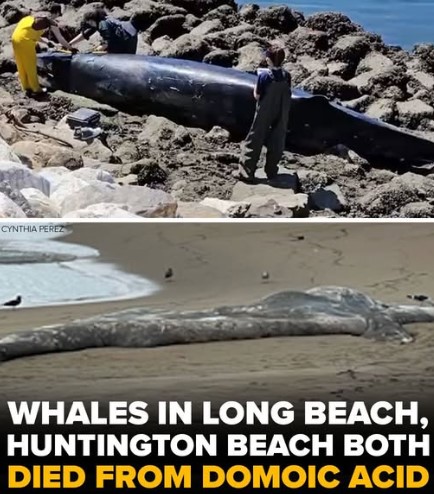Researchers have confirmed that a minke whale discovered in the Port of Long Beach and a young gray whale found in Huntington Beach both succumbed to toxicity from domoic acid. This marks a troubling development as a toxic algae bloom continues to wreak havoc on marine life, stretching along the Southern California coast from San Diego to San Luis Obispo.

The entire region is currently experiencing a severe environmental crisis, with the presence of domoic acid (DA), a neurotoxin produced by the algae. This is the fourth consecutive year that the area has faced such an issue, but experts believe this year’s bloom is the most severe to date.
According to the Southern California Coastal Ocean Observing System, high concentrations of domoic acid are at the core of the algae bloom, which has caused numerous marine fatalities. John Warner, CEO of the Marine Mammal Care Center in Los Angeles, described the situation as “the worst we’ve ever seen” in Southern California, particularly highlighting the unprecedented number of dolphin strandings. Over the past week, more than 50 dead or dying dolphins have been found along the coast of Los Angeles County, with 16 of them discovered in San Diego alone.
Michael Milstein from NOAA Fisheries noted that the number of animals showing symptoms of the toxicity—such as seizures or appearing dead or dying—has remained consistently high.
Sea lions, typically the primary victims of such toxic algae blooms, have been acting aggressively, sometimes attacking beachgoers. However, the toxic algae is now impacting marine life higher up the food chain. The algae blooms are fueled by a combination of wildfire debris and fertilizer runoff, which provide nutrients that fuel the growth of toxic algae. Small fish consume the algae, and in turn, marine mammals and birds ingest these fish, leading to potentially fatal levels of toxicity.
While sea lions and birds can sometimes be saved, the situation is dire for dolphins, as the toxicity is completely fatal for them. Despite this, researchers remain hopeful that marine populations will recover in the long term, as these species are known for their resilience, provided they have adequate food and resources.
Unfortunately, experts caution that immediate relief is unlikely, given the widespread nature of the algae bloom and its access to abundant nutrients.
Source: Metro.co.uk
